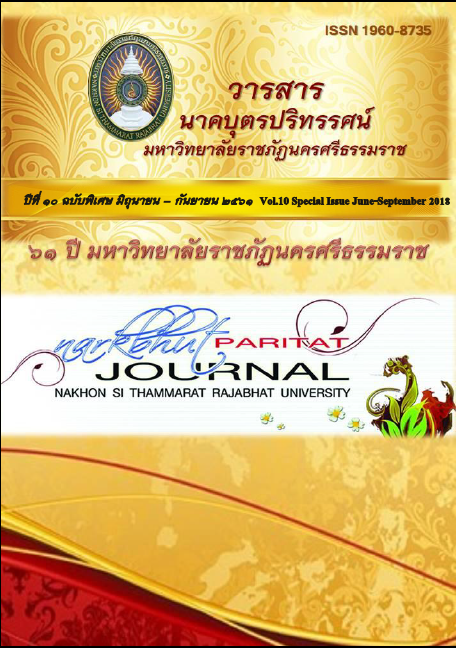การออกแบบโจทย์ปัญหาในการศึกษาชั้นเรียนที่มีความหมายสำหรับการคิดทางคณิตศาสตร์นักเรียน Process of Designing tasks Meaningful for Students’ Mathematical thinking using Lesson Study
Main Article Content
Abstract
The purpose of this research were 1) to study designing mathematical tasks meaningful for students in lesson study, and 2) to study students’ mathematical thinking of addition. The qualitative research regarded case study method. The case was grade 1 Lesson Study team in Watmahachaiwanaram School. The data were collected through participatory observation, field notes, and video recording. Descriptive and protocol analysis were used for data analysis. Results of the object revealed that 1) determining the lesson goal; 2) interpreting the mathematical tasks; 3) identifying the use of mathematical tasks; and 4) anticipating students’ approaches. 2) When the tasks are designed to be used in the classroom revealed that students learn in a meaningful of the mathematical thinking by understanding of the meanings addition. Student understand the connect between counting and operations of addition meaning is “increasing”. They use making tens to solve addition tasks.
Article Details
References
Brunei curriculum: implementation
issues and challenges. Progress report, "Collaborative Studies on Innovations for Teaching and Learning Mathematics in Different Cultures (II) - Lesson Study focusing on Mathematical Thinking -". CRICED: University of Tsukuba
[2] The National Council of Teachers of
Mathematics. (2000) . Principles and Standards for School Mathematics. Roston, VA: The National Council of Teachers of Mathematics.
[3] Hattori, K. (2010). Addition and
Subtraction: Introduction. In Isoda, M. & Nakamura, T. (Ed.). Journal of Japan Society of Mathematics Education. (p. 1). Japan: Bunshoudo Insatusho.
[4] D. Clarke & A. Roche (2010). Teachers’
Extent of the Use of Particular Task Types in Mathematics and Choices Behind That Use. https://files.eric.ed.gov/fulltext/ED520857.pdf
[5] Shimizu Y., Kaur B, R. Huang and D.J. Clark
(Eds.) (2010). Mathematical Task in Classrooms around the World. Sense publisher Takahashi, A., & Yoshida, M. (2004). Ideas for establishing Lesson-Study communities. Teaching Children Mathematics (May), 436–443
[6] Baba. (2007). How is lesson study
implemented?. In M. Isoda, M. Stephens, Y. Ohara and T. Miyakawa (eds.) Japanese Lesson Study in MATHEMATICS: Its Impact, Diveristy and Potential for Eductional Improvement. Danvers, MA: World Scientific Publishing Co. Pte. Ltd.
[7] Lieberman, J. (2009). Using Lesson Study
to Develop an Appreciation of and Competence in Task Design.
Task in Primary Mathematics Teacher Education: Purpose, Use and Exemplars, Mathematics Teacher Education, B.Clark, B., Grevholm, and R. Millmand (eds.). springer Science+Business Media LLC2009. p.11-24
[8] Inprasitha, M. (2010). One Feature of
Adaptive Lesson Study in Thailand: Designing Learning Unit. In C. S. Cho, S. G. Lee & Y. H. Choe (Eds.). Proceedings of the 45th National Meeting of Mathematics Education. (pp.193-206). Korea: Dongkook University, Gyeongju.
[9] ไมตรี อินทร์ประสิทธิ์. (2547). การสอนโดยใช้
วิธีการแบบเปิดในชั้นเรียนคณิตศาสตร์ของญี่ปุ่น. KKU Journal of Mathematics Education, 1(1),1-17.
[10] Roth & Ames (2014). Beiträge zum Mathematikunterricht 2014. (S. 1043–1046).
Münster: WTM-Verlag
[11] Takahashi, A., & Yoshida, M. (2004).
Ideas for establishing Lesson-Study communities. Teaching Children Mathematics (May), 436–443.
[12] Isoda, M. (2010). Elementary School Teaching Guide for the Japanese Course of
Study: Mathematics (Grade 1-6) with the English translation on the opposite
page. Japan: University of Tsukuba.

